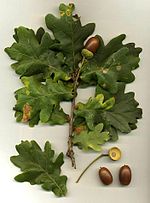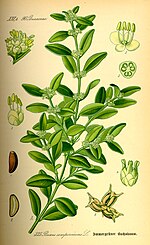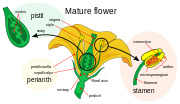identifying the pollen classes. The eudicots can be divided into two groups: the basal eudicots and the core eudicots. Basal eudicot is an informal name for a paraphyletic...
16 KB (1,409 words) - 16:05, 31 October 2024
group known as the basal eudicots. It is the most basal clade in this group; in other words, it is sister to the remaining eudicots. Widely known members...
9 KB (880 words) - 17:31, 19 October 2024
traditionally defined. The traditional dicots are thus a paraphyletic group. The eudicots are the largest monophyletic group within the dicotyledons. They are distinguished...
14 KB (784 words) - 08:32, 22 September 2024
Proteales, Ranunculales and Trochodendrales. Like the core eudicots (the rest of the eudicots), they have pollen grains with three colpi (grooves) or other...
25 KB (1,134 words) - 17:38, 21 August 2024
Pentapetalae (category Eudicots)
nomenclature, the Pentapetalae are a large group of eudicots that were informally referred to as the "core eudicots" in some papers on angiosperm phylogenetics...
33 KB (3,326 words) - 04:07, 8 April 2024
clade. This is one of three groups that comprise the Pentapetalae (core eudicots minus Gunnerales), the others being Dilleniales and the superasterids (Berberidopsidales...
13 KB (1,022 words) - 12:49, 4 October 2024
Nelumbonaceae (category Eudicot families)
an example of convergent evolution. Nelumbonaceae are highly modified eudicots belonging to the order Proteales, their closest living relatives being...
5 KB (414 words) - 15:47, 26 June 2024
introduced species and e indicates an extinct species. This division of the eudicots is shown in the following cladogram: Recurved sandwort (Minuartia recurva)...
82 KB (117 words) - 23:35, 23 June 2024
especially in relation to grasslands and understory. Typically, these are eudicots without woody stems. The word "forb" is derived from Greek phorbḗ (φορβή)...
5 KB (457 words) - 16:01, 20 October 2024
Mesangiospermae includes the following clades: Ceratophyllales Chloranthales eudicots magnoliidae monocots The mesangiosperms are usually recognized in classification...
11 KB (1,173 words) - 06:36, 19 September 2024
few hundred species, compared with hundreds of thousands of species of eudicots, monocots, and magnoliids. They diverged from the ancestral angiosperm...
7 KB (654 words) - 18:28, 27 July 2024
Dilleniaceae (category Eudicot families)
family in the phylogenetic tree and its classification among the other eudicots is uncertain. Some studies suggested that Dilleniaceae may be sister to...
7 KB (669 words) - 22:03, 27 September 2024
II system (of 2003) also recognizes this order, placing it in the clade Eudicots, with the following circumscription: order Proteales family Nelumbonaceae...
7 KB (710 words) - 17:25, 19 October 2024
the major division of flowering plants referred to as eudicots, specifically the core eudicots. This subgroup consists of the Dilleniaceae, superasterids...
77 KB (6,011 words) - 03:17, 3 October 2024
flowering plants is not evenly distributed. Nearly all species belong to the eudicot (75%), monocot (23%), and magnoliid (2%) clades. The remaining five clades...
80 KB (6,328 words) - 06:14, 11 November 2024
(cycads) Ginkgoales (Ginkgo) Pinopsida (conifers) Gnetopsida Angiospermae (flowering plants) Basal angiosperms Core angiosperms Magnoliids Monocots Eudicots...
95 KB (8,067 words) - 16:08, 5 November 2024
(cycads) Ginkgoales (Ginkgo) Pinopsida (conifers) Gnetopsida Angiospermae (flowering plants) Basal angiosperms Core angiosperms Magnoliids Monocots Eudicots...
138 KB (14,773 words) - 09:08, 30 October 2024
(cycads) Ginkgoales (Ginkgo) Pinopsida (conifers) Gnetopsida Angiospermae (flowering plants) Basal angiosperms Core angiosperms Magnoliids Monocots Eudicots...
23 KB (2,031 words) - 23:13, 8 November 2024
classification Kingdom: Plantae Clade: Tracheophytes Clade: Angiosperms Clade: Eudicots Clade: Rosids Order: Rosales Family: Rosaceae Genus: Malus Species: M. domestica...
101 KB (10,242 words) - 16:30, 8 November 2024
classification Kingdom: Plantae Clade: Tracheophytes Clade: Angiosperms Clade: Eudicots Clade: Rosids Order: Fagales Family: Fagaceae Subfamily: Quercoideae Genus:...
81 KB (7,883 words) - 07:23, 6 November 2024
would support the theory that they are just as old as the eudicots. The pollen of the eudicots dates back 125 million years, so the lineage of monocots...
116 KB (11,177 words) - 00:34, 12 November 2024
APG III system (section Probable sister of eudicots)
order Poales order Zingiberales probable sister of eudicots order Ceratophyllales clade eudicots family Sabiaceae—unplaced in an order order Buxales...
47 KB (3,194 words) - 04:17, 8 April 2024
APG IV system (section Probable sister of eudicots)
Magnoliidae Chloranthidae Lilidae (Monocots) Ceratophyllidae Eudicots...
40 KB (2,558 words) - 15:03, 19 September 2024
Buxales (category Eudicots)
The Buxales are placed within the eudicots but outside the core eudicots, in a paraphyletic group of basal eudicots. The monophyly of the order and its...
9 KB (970 words) - 17:22, 19 October 2024
as APG III and APG IV, this order was the first to derive from the core eudicots. Both families contain ellagic acid. Phloem cells contain a large number...
4 KB (415 words) - 03:01, 8 April 2024
Sterile Stamens or Bracts? The Origin and Evolution of Petals in the Core Eudicots". Annals of Botany. 100 (3): 621–630. doi:10.1093/aob/mcm076. PMC 2533615...
6 KB (670 words) - 09:43, 24 October 2024
throughout). Most syncarpous monocots and some eudicots have open styles, while many syncarpous eudicots and grasses have closed (solid) styles containing...
9 KB (872 words) - 16:37, 10 July 2024
classification Kingdom: Plantae Clade: Tracheophytes Clade: Angiosperms Clade: Eudicots Clade: Rosids Order: Fabales Family: Fabaceae Subfamily: Faboideae Genus:...
78 KB (8,065 words) - 16:47, 28 October 2024
classification Kingdom: Plantae Clade: Tracheophytes Clade: Angiosperms Clade: Eudicots Order: Proteales Family: Nelumbonaceae Genus: Nelumbo Species: N. nucifera...
71 KB (8,236 words) - 04:43, 15 November 2024




























